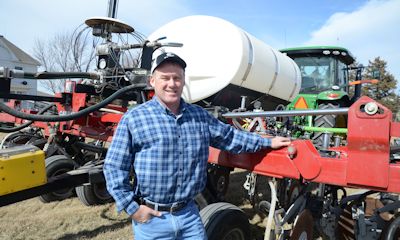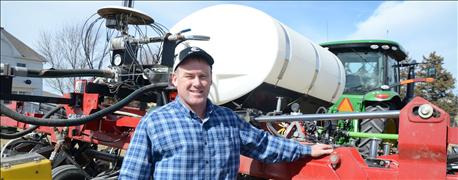
For ten years, John Niemeyer has used a corn-on-corn rotation on his farm in Gage County. For Niemeyer, a continuous corn rotation provides a greater return on investment compared to a corn-soybean rotation, but he notes it takes a different kind of management – especially when it comes to nitrogen.
 BANDING TAPPS: John Niemeyer and his Exactrix-equipped Case applicator he uses to apply variable rate anhydrous ammonia APP and ATS. Banding anhydrous with APP and ATS creates triammonium polyphosphate sulfate (TAPPS) in a crystalized polymer that stabilizes nitrogen and makes phosphorus more readily available for multiple years.
BANDING TAPPS: John Niemeyer and his Exactrix-equipped Case applicator he uses to apply variable rate anhydrous ammonia APP and ATS. Banding anhydrous with APP and ATS creates triammonium polyphosphate sulfate (TAPPS) in a crystalized polymer that stabilizes nitrogen and makes phosphorus more readily available for multiple years.
"It's been a learning experience," Niemeyer says. "Corn residue typically does not break down as quickly, just because it's got a higher carbon to nitrogen ratio. Soybean stubble is better able to mineralize that residue and provide it to the plant throughout the year. Corn stubble takes longer to break down, and it ties up some of my nitrogen when I apply it, and it doesn't necessarily release it until later in the season."
"Consequently I've had to adjust my N management a little bit," Niemeyer adds. "I'm going to multiple applications of N through the season in smaller amounts."
Despite not rotating with a legume crop, Niemeyer has been able to reduce his nitrogen costs – in an average year he's been able to push rates down to 7/10 of a pound per bushel to the acre yield.
Setting a good foundation
A big piece of the puzzle is Niemeyer's pre-plant nitrogen application. In mid-March, he applies variable rate anhydrous ammonia NH3, with ammonium polyphosphate (APP), 10-34-0, and ammonium thiosulfate (ATS), 12-0-0-26, using yield maps and soil test data to delineate fields into four or five zones.
Niemeyer bands these products through Exactrix P-51 low-disturbance disk openers on 15 inch centers, The openers use a streaming flow anhydrous delivery system to keep anhydrous in a pure liquid state up to the injection point using high pressure, allowing for more uniform application.
 SITE-SPECIFIC: Niemeyer uses yield maps and soil test data to delineate fields into four or five zones for variable-rate anhydrous ammonia, APP, and ATS applications.
SITE-SPECIFIC: Niemeyer uses yield maps and soil test data to delineate fields into four or five zones for variable-rate anhydrous ammonia, APP, and ATS applications.
The bands are on 15 inch centers at a 6 inch depth – another factor in reaching higher corn yields. This technique allows banding of TAPPS and planting the same day without burning corn roots.
Banding anhydrous with APP and ATS creates triammonium polyphosphate sulfate (TAPPS) in a crystalized polymer that stabilizes nitrogen and makes phosphorus more readily available for multiple years. "That crystallization is so unique because you can't buy it, you've got to build it," says Guy Swanson, inventor and president of Exactrix in Spokane, Wash. who makes frequent visits to the Plains to work with growers like Niemeyer on nitrogen management.
Applying TAPPS has allowed Niemeyer to cut back on both nitrogen rates and phosphorus rates. "I've been able to reduce my rates on TAPPS to less than what I would apply using a dry system. I'm probably saving 10% to 20% on inputs," he says. "I've been able to maintain or improve my [Bray] P1 levels consistently, and I'm able to reduce my rates, so it's a win-win."
Have a backup plan
Last year saw the wettest May on record for many in eastern Nebraska. Some locations in southeast Nebraska received over seven inches of rain on May 7, 2015.
In Niemeyer's part of the state, where finer clay soils are prevalent, denitrification was a problem. So, he rented a high-clearance applicator with drop nozzles to make sidedress applications, and soon after, he says he "saw the light" and bought a high-clearance applicator of his own to apply nitrogen in-season.
The ability to apply nitrogen shortly before the corn needs it most makes it possible to replace nitrogen lost to leaching or denitrification, explains Jim Schepers, retired USDA-ARS soil scientist and precision ag consultant based in Lincoln. "It makes good sense to avoid laying all of your cards on the table at planting time and hope for the best," Schepers says. "Holding back a few cards gives you an edge and might even mean that you can win without even laying your final card on the table. By adopting in-season N management, producers are basically bluffing Mother Nature."
"Sidedress applications really made a difference last year – I was seeing a 40-bushel increase on sidedress acres versus those that weren't sidedressed," Niemeyer says. "I think it boils down to you've got to have a Plan B – whether it's nitrogen through your pivot, or using your high-clearance with drop nozzles."
Look for more information in an upcoming print issue of Nebraska Farmer.
About the Author(s)
You May Also Like






